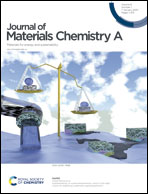Construction of uniform buried pn junctions on pyramid Si photocathodes using a facile and safe spin-on method for photoelectrochemical water splitting†
Abstract
Czochralski silicon (p type) with buried pn junctions by surface doping is widely used in photovoltaic (PV) and photoelectrochemical (PEC) water splitting systems. However, phosphorus oxychloride (POCl3) and phosphine (PH3) as phosphorous doping sources that are widely used in industry are of high toxicity. On the other hand, commercially available spin-on dopants (SODs) for laboratory-scale applications are polymer solutions with a large number of phosphorous polymers, leading to a high viscosity. Thus, it is difficult to realize uniform doping on pyramidal surface textured (pyramid) Si substrates using SODs. This study describes the construction of uniform buried pn junctions on pyramid silicon by spin coating ammonium dihydrogen phosphate (ADP) aqueous solution as the phosphorous source, which is of low viscosity and can decompose into P2O5 at high temperatures. Owing to the improved charge carrier separation at the uniform junction, the pn+Si/TiO2/Pt photocathode using low viscosity dopants exhibits a high onset potential of 0.58 V vs. the reversible hydrogen electrode (RHE) and improves the applied bias photon current efficiency from 3.73% (using SOD polymer solution) to 10.6% in 1 M HClO4. When combining the optimized photocathode with a BiVO4 photoanode to form a PEC tandem configuration, a stable solar-to-hydrogen conversion efficiency of 2.09% is achieved under 1 sun illumination.



 Please wait while we load your content...
Please wait while we load your content...